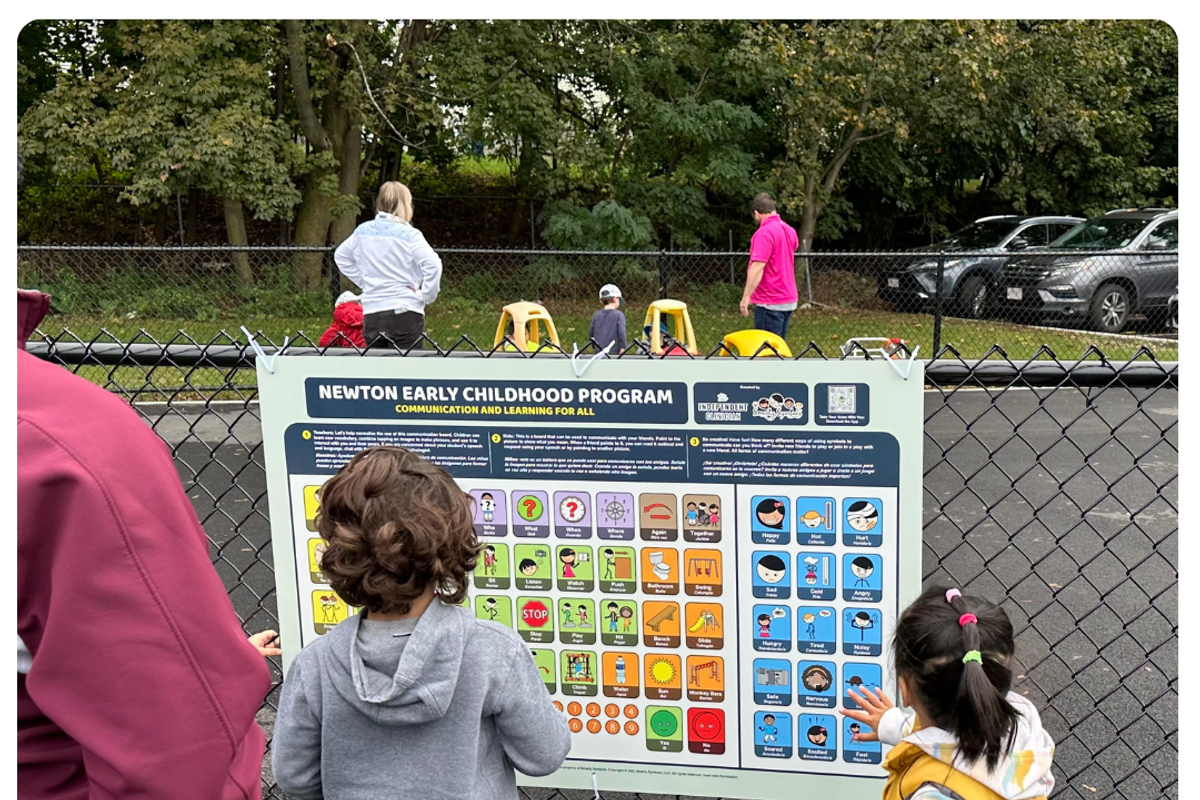Hundreds of parks and playgrounds have added these colorful picture boards for autistic kids
Communication boards for nonverbal autism are a huge game changer.

Communication boards help nonverbal kids communicate at the park.
Taking your kids to the playground is supposed to be fun.
You chase them around, hold them up on the monkey bars, follow them down the slide — it's a hoot!
(Or, if you're exhausted and overstimulated like so many parents, you take a little quiet time to scroll your phone on the bench while your child plays happily — there's zero shame in doing so.)
But for parents of children with autism or other special needs — especially when those kids are nonverbal — a trip to the park can be filled with stress and anxiety.
Being in an outside environment that you can't control and having few ways to clearly communicate with your child is stressful and even dangerous.
Now more and more communities are installing special picture boards that make playgrounds and other public spaces more accessible to nonverbal kids.
Autism communication boards, more formally known as Picture Exchange Communication System (PECS) boards, are a game-changer.
These larges signs feature colorful pictures and icons that help children — and people of all ages — with verbal challenges communicate.

Typically, you'll find them at playgrounds and public parks, where the boards might have pictures corresponding to things a child might want to do like Climb, or Slide.

There may be pictures for Friend or for Share, or for things kids might want like Food, Water, or to go to the Bathroom.
Kids are able to point at the little logos to communicate efficiently and clearly with their caretakers or even with other kids.

For children with budding language skills, the boards often include a full alphabet so kids can spell out words by pointing or touching.
What's amazing is that these boards not only make playgrounds and parks safer and more inclusive for autism families, they actually open up a gateway for nonverbal kids to play with other children.
Parents may be well-versed in some of the nonverbal communication methods their kids use, but other children at the park might not be. These boards make it easier for a child with autism to find a friend to go down the slide with them or go on the climbing wall together.
As an added bonus, public PECS boards invoke a lot of curiosity which helps kids and even adults learn more about folks who may have different ways of communicating.
And the boards aren't just for nonverbal children with autism! They're a great and fun tool for younger children who are just learning how to read and speak, empowering them to communicate and interact more fully with the world around them.
At home, children with autism often have smaller versions of these boards — or they have special tablets loaded with tools to help them communicate.
But out in the chaos of the real-world and without these tools, communications breakdowns are a major risk.
With 1 in every 36 children having autism (a number that's been on the rise) according to the CDC, these boards are a crucial public health investment for towns across the country.
PECS boards in public spaces is an idea that's really catching on. There are dozens of news stories from the last year or two of counties or town in the U.S. and UK, in particular, installing these boards.
Union County in New Jersey added boards to several of its most popular parks.
Teddy Bear Park in Lake Placid got a custom board earlier this year.
And Oyster Bay in Long Island, NY added communication boards to nearly a dozen of its parks and beaches!
You can even find highly customized boards in places like school libraries, school nurse offices, or sports fields — all with special pictures and communications tools that are suited to that particular environment.
Smarty Symbols, one of the main manufacturers and advocates for the use of these boards, has shipped hundreds of boards since 2022.
The prevalence of PECS or autism communication boards in public spaces is a truly amazing sign of progress
Our understanding of nonverbal autism and our willingness to make public space more inclusive has come a long way.
Therapy designed to encourage or even "force" nonverbal children with autism to speak is highly controversial, and there's a lot of debate over its ethics and effectiveness.
But what's clear is that tools like picture boards and communication boards do not delay or hinder anyone's ability to learn to read or speak.
They're an extra tool that keeps kids safe and happy — which is exactly what every kid should feel when they're at the playground with their family.

